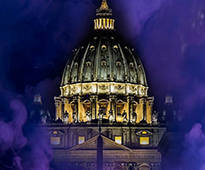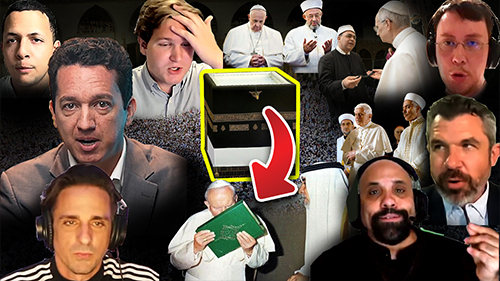| Recent Featured Videos and Articles | Eastern “Orthodoxy” Refuted | How To Avoid Sin | The Antichrist Identified! | What Fake Christians Get Wrong About Ephesians | Why So Many Can't Believe | “Magicians” Prove A Spiritual World Exists | Amazing Evidence For God | News Links |
| Vatican II “Catholic” Church Exposed | Steps To Convert | Outside The Church There Is No Salvation | E-Exchanges | The Holy Rosary | Padre Pio | Traditional Catholic Issues And Groups | Help Save Souls: Donate |  |









 " />
" /> " />
" /> " />
" /> " />
" /> " />
" />




The Keys of St. Peter and his Unfailing Faith
It is a fact of history, scripture and tradition that Our Lord Jesus Christ founded His universal Church (the Catholic Church) upon St. Peter.
Our Lord made St. Peter the first pope, entrusted to him His entire flock, and gave him supreme authority in the universal Church of Christ.
And with the supreme authority that Our Lord Jesus Christ conferred upon St. Peter (and his successors, the popes) comes what is called Papal Infallibility. Papal Infallibility is inseparable from Papal Supremacy – there was no point for Christ to make St. Peter the head of His Church (as Christ clearly did) if St. Peter or his successors, the popes, could err when exercising that supreme authority to teach on a point of Faith. The supreme authority must be unfailing on binding matters of Faith and morals or else it is no true authority from Christ at all.
Papal Infallibility does not mean that a pope cannot err at all and it does not mean that a pope cannot lose his soul and be damned in Hell for grave sin. It means that the successors of St. Peter (the popes of the Catholic Church) cannot err when authoritatively teaching on a point of Faith or morals to be held by the entire Church of Christ. We find the promise of the unfailing faith for St. Peter and his successors referred to by Christ in Luke 22.
Satan desired to sift all the Apostles (plural) like wheat, but Jesus prayed for Simon Peter (singular), that his faith fail not. Jesus is saying that St. Peter and his successors (the popes of the Catholic Church) have an unfailing faith when authoritatively teaching a point of faith or morals to be held by the entire Church of Christ.
And this truth has been held since the earliest times in the Catholic Church.
The promise of Christ to St. Peter that his faith cannot fail (i.e., is indefectible) presupposes that Peter’s faith – and the office Jesus establishes in Peter – is infallible. For that which is unfailing in matters of faith must be infallible. Papal Infallibility is therefore directly connected to Christ’s promise to St. Peter (and his successors) in Luke 22 concerning Peter’s unfailing Faith. Papal Infallibility is also found in Christ’s promise to Peter in Matthew 16. Jesus declares that whatever Peter binds (i.e., whatever he declares must be held by the universal Church) is also bound in Heaven. Since Heaven cannot bind error, the things St. Peter and his successors bind on the universal Church must always be true. That’s infallibility. Although this truth was believed since the beginning of the Church, it was specifically defined as a dogma at the First Vatican Council in 1870.
But how does one know when a pope is exercising his unfailing Faith to infallibly teach from the Chair of St. Peter? The answer is that we know from the language that the pope uses or the manner in which the pope teaches. Vatican I defined two requirements which must be fulfilled: 1) when the pope is carrying out his duty as pastor and teacher of all Christians in accord with his supreme apostolic authority; 2) when he explains a doctrine on faith or morals to be held by the entire Church of Christ. A pope can fulfill both of these requirements in just one line, by anathematizing a false opinion (such as many dogmatic councils) or by saying “By our apostolic authority we declare…” or by saying “We believe, profess, and teach” or by using words of similar importance and meaning, which indicate that the pope is teaching the whole Church on Faith in a definitive and binding fashion.
So, when a pope teaches from the Chair of Peter in the manner stipulated above he cannot be wrong. If he could be wrong, then the Church of Christ could be officially led into error, and Christ’s promise to St. Peter and His Church would fail (which is impossible). That which is taught from the Chair of Peter by the popes of the Catholic Church is the teaching of Jesus Christ Himself. To reject that which is taught by the popes from the Chair of Peter is simply to despise Jesus Christ Himself.
THE CHAIR OF PETER SPEAKS THE TRUTH THAT CHRIST HIMSELF DELIVERED
The truths of faith which have been proclaimed by the popes speaking infallibly from the Chair of Peter are called dogmas. The dogmas make up what is called the deposit of Faith. And the deposit of Faith ended with the death of the last apostle.
This means that when a pope defines a dogma from the Chair of Peter he does not make the dogma true, but rather he proclaims what is already true, what has already been revealed by Christ and delivered to the Apostles. The dogmas are therefore unchangeable, of course. One of these dogmas in the deposit of Faith is that Outside the Catholic Church There is No Salvation. Since this is the teaching of Jesus Christ, one is not allowed to dispute this dogma or to question it; one must simply accept it. It does not matter if one doesn’t like the dogma, doesn’t understand the dogma, or doesn’t see justice in the dogma. If one doesn’t accept it as infallibly true then one simply does not accept Jesus Christ, because the dogma comes to us from Jesus Christ.
Those who refuse to believe in the dogma Outside the Church There is No Salvation until they understand how there is justice in it are simply withholding their Faith in Christ’s revelation. Those with the true Faith in Christ (and His Church) accept His teaching first and understand the truth in it (i.e., why it is true) second. A Catholic does not withhold his belief in Christ’s revelation until he can understand it. That is the mentality of a faithless heretic who possesses insufferable pride. St. Anselm sums up the true Catholic outlook on this point.
[1] Denzinger 1837.
[2] Denzinger 1836.
[3] Denzinger 163.
[4] Denzinger 1839.
[5] The Papal Encyclicals, by Claudia Carlen, Raleigh: The Pierian Press, 1990,Vol. 2 (1878-1903), p. 394.
[6] Denzinger 2021.
[7] The Papal Encyclicals, Vol. 2 (1878-1903), p. 394.
[8] Fr. Christopher Rengers, The 33 Doctors of the Church, Rockford: IL, Tan Books, 2000, p. 273.
Sign up for our free e-mail list to see future vaticancatholic.com videos and articles.
Recent Content
^